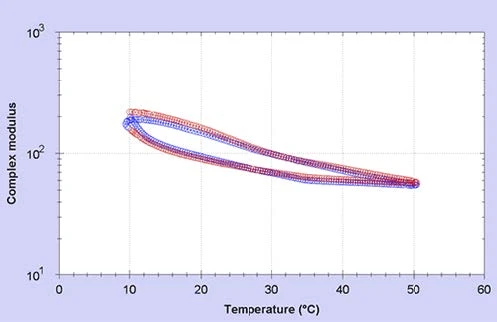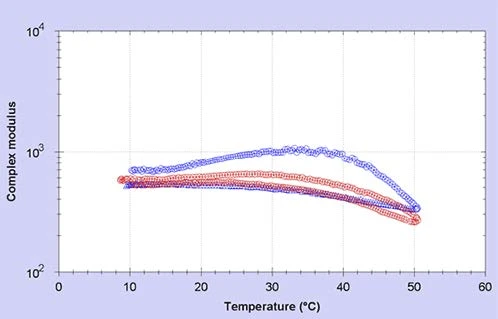Introduction
Assessing the long term stability of a product - such as personal care and household products, foodstuffs and beverages, and paints, inks and coatings – can be both a tedious and time consuming process and must account for the environmental conditions that the product is likely to encounter during its lifetime. It’s not unusual for such products to be exposed to temperatures ranging from below freezing to as high as 50°C when being transported in trucks, and stored in warehouses. Under such conditions, products may deteriorate and become visually unacceptable and/or less effective.
In order to determine the temperature stability of such products it is necessary to monitor the rheological behaviour of the product through a number of temperature cycles. This is best assessed by monitoring the complex modulus (G*) as a function of temperature. A thermally stable system should show similar cycling behaviour since the microstructure should not have changed. For thermally unstable samples, temperature cycling will cause the complex modulus to have a different temperature dependence on each thermal cycle.
This application note shows methodology and data for thermal stability for two skin cream product formulations.
Experimental
- Two skin cream products were evaluated for thermal stability over the temperature range from 10°C to 50°.
- Rotational rheometer measurements were made using a Kinexus rheometer with a Peltier plate cartridge and a cone and plate measuring system1, and utilizing standard pre-configured sequences in rSpace software.
- A standard loading sequence was used to ensure that the sample was subject to a consistent and controllable loading protocol.
- A strain-controlled amplitude sweep is performed to measure the length of the Linear ViscoElastic Region (Région Viscoélastique Linéaire (LVER)In the LVER, applied stresses are insufficient to cause structural breakdown (yielding) of the structure and hence important micro-structural properties are being measured.LVER), and to determine an appropriate strain value to be used in the subsequent temperature ramp test (the LVER determination is automated within rSpace software, and the strain value determined is fed forward into the next part of the sequence).
- A single frequency strain-controlled temperature ramp test is performed, with the temperature range set to the extremes of temperature that a product may encounter during transport and storage – in this case from 10°C to 50°C.
- The temperature is ramped up and down between the set temperature limits, with the number of repeat cycles defined as required.
- Product thermal stability is quantified by comparing the plots of G* versus temperature and applying curve statistics to analyse differences in the data for the different cycles to assess how far apart the curves are against set limits e.g. a value of <5% difference at each point across the data set may be deemed to be thermally stable, and >5% difference may be deemed to be thermally unstable, depending on product requirements.
Results and Discussion
Plots of complex modulus against temperature for two repeat thermal cycles are shown for sample A (see Figure 1) and sample B (see Figure 2).
For sample A, the curves from both temperature cycles show good overlap, and this is confirmed from statistical analysis output in the rSpace software which shows that the repeat data for the second cycle is all within the ±5% tolerance limit set. On the basis of the set criteria, sample A is a thermally stable sample. For sample B however, there is clearly a difference in the data over the two temperature cycles, particularly on the ramp down section of the second thermal cycle where there is a significant increase in the complex modulus. Applying the same curve statistics, the repeat data for sample B was outside the ±5% tolerance limit set. On the basis of the set criteria, sample B is a thermally unstable sample.


Conclusion
The testing of two skin cream samples has shown that it is possible to determine product thermal stability by means of a temperature cycling tests at a single frequency. For the samples tested, sample A is thermally stable and will not degrade during transport and storage, while sample B is not thermally stable and is more likely to degrade during transport and storage due to temperature extremes.
Please note...
that a parallel plate geometry or a cylindrical geometry can also be used for this testing - with these geometries being preferred for dispersions and emulsions with large particle sizes. A sand blasted geometry should be considered if the material is likely to show wall slip effects.